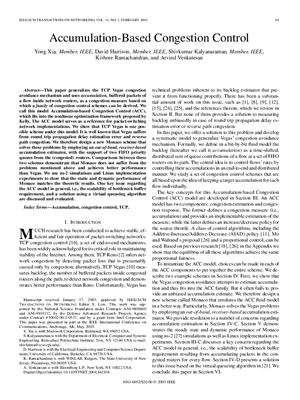IEEE/ACM TRANSACTIONS ON NETWORKING, VOL. 13, NO. 1, FEBRUARY
2005.
This paper generalizes the TCP Vegas congestion avoidance mechanism and uses accumulation, buffered packets of a ?ow inside network routers, as a congestion measure based on which a family of congestion control schemes can be derived. This model is called Accumulation-based Congestion Control (ACC), which ?ts into the nonlinear optimization framework proposed by Kelly. The ACC model serves as a reference for packet-switching network implementations. TCP Vegas is one possible scheme under this model. It is well known that Vegas suffers from round trip propagation delay estimation error and reverse path congestion. A new Monaco scheme is designed that solves these problems by employing an out-of-band, receiver-based accumulation estimator, with the support of two FIFO priority queues from the (congested) routers. Comparisons between these two schemes demonstrate that Monaco does not suffer from the problems mentioned above and achieves better performance than Vegas. NS-2 simulations and Linux implementation experiments are used to show that the static and dynamic performance of Monaco matches the theoretic results. One key issue regarding the ACC model in general, i.e. , the scalability of bottleneck buffer requirement, and a solution using a virtual queueing algorithm are discussed and evaluated.
Accumulation, congestion control, TCP.
This paper generalizes the TCP Vegas congestion avoidance mechanism and uses accumulation, buffered packets of a ?ow inside network routers, as a congestion measure based on which a family of congestion control schemes can be derived. This model is called Accumulation-based Congestion Control (ACC), which ?ts into the nonlinear optimization framework proposed by Kelly. The ACC model serves as a reference for packet-switching network implementations. TCP Vegas is one possible scheme under this model. It is well known that Vegas suffers from round trip propagation delay estimation error and reverse path congestion. A new Monaco scheme is designed that solves these problems by employing an out-of-band, receiver-based accumulation estimator, with the support of two FIFO priority queues from the (congested) routers. Comparisons between these two schemes demonstrate that Monaco does not suffer from the problems mentioned above and achieves better performance than Vegas. NS-2 simulations and Linux implementation experiments are used to show that the static and dynamic performance of Monaco matches the theoretic results. One key issue regarding the ACC model in general, i.e. , the scalability of bottleneck buffer requirement, and a solution using a virtual queueing algorithm are discussed and evaluated.
Accumulation, congestion control, TCP.

